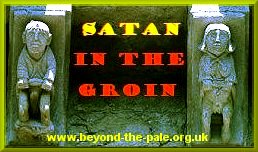skip poem, go straight to Synopsis
Anthony Weir
SHEELA-NA-GIG
Lichen-spotted, weather-beaten, turnip-headed
crude stone parody of wrinkled woman with
staring eyes, ribs like scars and paps like bladders
pulls at her fissure of fate:
no fisher of men,
bulbous and squat
she came from Attica and Alexandria
to take her stony place - amongst outnumbering
ithyphallic, concupiscent men
luxuriating lewdly in lubricious lechery
upon (at least) a hundred
churches off the Pilgrim Road -
to assist us in the overweening
struggle for Redemption.
Then carved by virgin sculptors or sculptresses
she did her ignorant and dismal duty
in the British Isles -
and later sailed to India
to be transformed to gorgeous goddess,
sinuous, sensual, celestial.
Unbothered by history or boring research
or even by going and looking,
the wishful ignorant think she is some sort of Divine
Whore or Hag or Mother Goddess, some Magical
Utopian Feminine - even though she's ten metres up
and barely visible upon a castle wall,
thrice the height of a man above us on a church's gable,
or set sideways on an abbey quoin
for every pious lord and clerk to see.
The truth is - as always - much darker.
She is simply the sign
that the houses, the hovels,
the castle, the church and the ditches
of the parish and district
were once 'cleansed' of 'witches'.
|
The
starting-point of any study of sheela-na-gigs has to be an 11th-12th
century Christian perspective which may be totally strange to the modern
Western person. We should remember that (for example) borrowing money
with interest (i.e. capitalism) was not allowed officially by the Catholic
Church until the late 19th century under Pius IX - although the first
known capitalist venture was the financing and building of a series
of water-mills on the river Garonne near Toulouse in the 12th century.
This was some 600 years after the Church officially permitted torture
- by the Inquisition set up during the 'Albigensian' genocide.
The monks of the 12th century were very worried about the rise of the towns which resulted partly from the boom which the monasteries had helped to create, partly because of wealth generated by the land-grab in Languedoc and the bloody "Reconquest" of Spain from the Moors, partly because of the Crusades. With the towns came the rise in importance of bishroprics which were of course corrupt. With them came the increase in power of the papacy which was of course corrupt. The monks saw that the whole of Christianity was sliding into the jaws of Hell via the money economy (which always produces corruption) that they loathed. The money economy created poverty, because the rich need the poor to set and measure themselves against. The rich (in the immoral towns) were indulging themselves shamelessly in Luxury (sex, food, music, jousting, jongleurs, etc.), so the monks (especially the Cluniac Benedictines) made Sermons in Stone out of their churches and abbeys, and, by imitation, this filtered down into the rural parishes, too. Thus on French and Spanish churches particularly carvings can be seen which expose wealth (Avaritia), gluttony, drunkenness, hedonism and sex (Luxuria and Concupiscentia) as the sins which will lead directly to Hell. Luxuria (really the sins of decadence due to luxury) and Avaritia were the two most serious, and these not infrequently occur in important places on churches, such as on doorway capitals and on transept capitals - as well as on the corbels of apses (chevets in French) and naves. Even explicit Sodomy and Bestiality are to be found represented on a few nave-capitals. Exhibitionists and men with moneybags significantly overlook market squares as minatory carvings to keep people on the straight and narrow. This is the inescapable background of the sheela-na-gigs. How they transformed from one of dozens of motifs of sin on churches (beast-heads, devils, acrobats and other sinful and 'unnatural' entertainers), into lone figures on Insular churches and Irish castles is so far inexplicable. Remembering that up until the Renaissance, sculptures (apart from alleged portraits) were more symbolic than literal/representational, Feminist suggestions just don't fit. Most of these lone figures seem to be 14th century. Why would goddess-worship suddenly appear out of nowhere, at churches rather than in the woods, when the Catholic church had realised by the 12th century that it was lacking in this respect, and had instituted a rapid and successful campaign to make the Virgin Mary into an all-powerful quasi-goddess, a direct intercessor with God ? The Cult of the Virgin Mary followed hot on the heels of a brief cult of Mary Magdalene who, when the monks became really worried about the way things were going, became very important as The Reformed Woman along with Lazarus the Beggar whose Sores were Licked by his Dog under the Table of the Damned Rich Man, Dives. Two of the art-historically-most-important churches in Christendom are dedicated to la Madeleine (Vézelay) and Saint-Lazare (Autun). These names survive importantly in Paris today. There was absolutely no need for Goddess Worship until very recently, when, naturally it appeared romantically after "The Death of God", in the 19th century, when most "traditions" were invented or heavily decorated - from Scottish Tartans to Maypole Dancing. This new Nationalism started in Britain (the first country to lose rural traditions and connection with Nature and the Land), spread to Ireland where Nationalists of all types (including Protestant ones like Yeats) quite brazenly re-wrote history and portrayed the Irish as pure, sweet victims of the nasty Anglo-Saxon Protestants. (As in England the sins of Thomas Cromwell, henchman of England's Saddam Hussain, Henry VIII who sent a million refugees out on the road and into Europe, were visited upon Oliver Cromwell, who was not an iconoclast nor indeed a vengeful man at all.) The sheela-na-gigs didn't quite fit into this perniciously narrow doctrine, which is why so few Irish people to this day are interested in them - or for that matter in Ireland's megaliths, which have no appeal to the political consciousness. But the Protestant English had no such inhibitions, and the Green Man and sheela-na-gig publishing-industries got going, along with a renewed interest in Arthurian Myth, Robin Hood and all that nationalist stuff. France, which must have 10,000 "Green Men" on its churches, along with even more interesting and curious motifs (such as column-swallowers), did not have this industry. Its nationalism didn't need this kind of concoction - in fact it was much more interested in getting its population to speak French. Breton, Provençal and Occitan had to be suppressed to prevent regionalism splitting France as it had done during and after the Revolution. It took a long time to do this - right into the 20th century. Ronald Hutton has well shown how modern needs make people create false histories to project upon the past - whether it is Boadicea/Boudicca, Robin Hood, King Arthur or Queen Elizabeth I. Ireland, now that it feels itself a respectable and respected nation in the European Union has (80 years after independence), significantly, started to dump its puritan, deValeran nationalism and to reclaim some sort of objectivity about the past. It sees itself as part of a European continuum. But Britain, still angry and grieving over loss of its sordid empire, still fighting the 13th century Hundred Years War with France, seems to get more and more nationalistic. America is doing something similar, inventing the War on Terror to mask what is in effect a War on the Rest of the World. As the French keep observing, there's something really bloody-minded about the Anglo-Saxons (though one must remember that in French, the word 'anglosaxon' is a codeword for 'Protestant'). But to return to the sheelas. The 'feminist' arguments largely depend on the assumed repression or suppression of women's sexuality. That this is not the case at all is illustrated by the famous case of a certain Alice in 15th century York. In 1433 she brought a case against her husband John on grounds of impotence. Part of her evidence revealed that she had arranged for him to be formally seduced by no fewer than seven women altogether, who warmed their hands and fondled his genitals and plied him with beer - unsurprisingly to no avail. The judgment declared publically by the church court in York Minster found that John was indeed impotent and annulled the marriage. Annulment
on grounds of impotence (generally male, cf. Elizabeth Shore's annulment
in 1476) was not uncommon, even though canon law did not state that
consummation was necessary to make the marriage valid. (see
The Royal Bastards of Medieval England by Chris Given-Wilson
and Alice Curteis; In France at the same time, such cases were common - and sometimes required the defendant men to try and perform before the court. These cases show that women's sexuality was no hole-and-corner matter, and their power was not nil. The other interesting suggestion being promoted now is that they are talismanic Aids to Childbirth. This seems plausible, except that, as ever, the Irish Castle figures are anomalous - and except that their relative rarity amongst the thousands of mediæval churches in the British Isles needs to be explained. As indeed do the obviously-related (if rare) male figures. So far the only theory which accounts for the Irish Castle figures is my 'Witches in Ossory' theory (summarised in the poem above), which is, however, hardly more convincing than any other.
ESSENTIAL READING
• The Triumph of the Moon: A History of Modern Pagan Witchcraft (1999, 2001) • • The Rise and Fall of Merry England: The Ritual Year, 1400-1700 (1994, 2001) • • Witches, Druids and King Arthur (2003) • |


